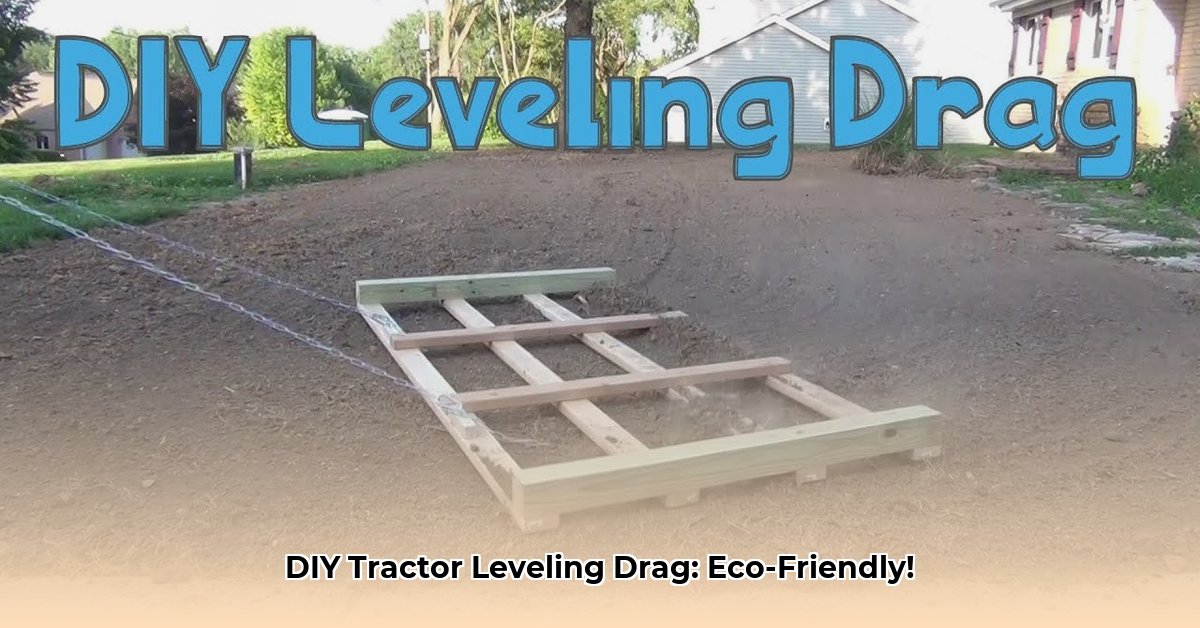
Leveling Drag for Tractor: A Sustainable Solution
Tired of uneven land hindering your farming or landscaping projects? Building your own leveling drag offers a cost-effective and environmentally friendly alternative to purchasing a commercial model. This guide provides step-by-step instructions for creating two different types of DIY leveling drags, along with tips for usage, maintenance, and incorporating sustainable practices into your land management. For more DIY tractor attachment ideas, check out this helpful website.
Choosing the Right Leveling Drag: DIY or Commercial?
The decision between a DIY and commercial leveling drag hinges on several factors: project scale, material availability, budget, and your skills and time. Commercial options offer durability and a polished finish, ideal for extensive projects. However, DIY drags are perfect for smaller jobs (gardens, small fields), allowing for cost savings and creative use of repurposed materials—a significant advantage for sustainable agriculture and landscaping.
Here's a decision tree to guide your choice:
| Project Scale | Material Availability | Budget | Recommended Approach |
|---|---|---|---|
| Small (garden, yard) | Abundant scrap metal/wood | Limited | DIY (chain link or wood) |
| Medium (small field) | Some scrap, readily available lumber | Moderate | DIY or commercial (depending on skills and time) |
| Large (farm field) | Limited scrap materials | Generous | Commercial |
Remember, even with a commercial drag, DIY modifications might be needed for optimal performance.
DIY Leveling Drag Designs: Two Eco-Friendly Options
Let's explore two popular DIY designs:
Chain Link Leveling Drag: The Recycler's Delight
This budget-friendly option repurposes old chain-link fencing, minimizing waste and environmental impact. It's remarkably effective for smaller projects.
Materials:
- Sturdy chain-link fencing sections (assess for damage before use)
- Heavy-duty wire (for secure connections)
- Heavy-duty chains or ropes (for attaching to the tractor's three-point hitch)
- Optional: Weights (old tires, sandbags, or rocks) to enhance effectiveness.
Step-by-Step Instructions:
- Assess and Prepare: Inspect fencing sections for damage; discard unreliable pieces.
- Connect Sections: Overlap sections to reach your desired width. Use heavy-duty wire to firmly join them together, ensuring strong, tension-resistant connections.
- Add Weight (Optional): Depending on your soil and project size, add weight for optimal leveling. Securely attach weights to the frame.
- Attach to Tractor: Carefully connect the drag to your tractor's three-point hitch, following your tractor's manual for safe attachment.
Lumber Leveling Drag: Sturdy and Sustainable
For a more robust and durable option, consider a lumber leveling drag. While initial costs are slightly higher, its longevity makes it worthwhile for repeated use.
Materials:
- Strong, untreated lumber (2x6s or 4x4s—dimensions depend on drag size)
- Heavy-duty bolts, washers, and nuts (for secure construction. Avoid nails for superior strength)
- Optional: Weights (rocks, sandbags)
- Heavy-duty chains or a custom hitch (may require welding skills)
Step-by-Step Instructions:
- Design and Cut: Plan dimensions based on needs. Cut lumber to precise lengths.
- Assemble Frame: Create a sturdy rectangular frame, ensuring square joints and secure fastenings with bolts.
- Add Support and Weight: Incorporate cross bracing for stability. Add weight as needed for effective leveling.
- Create Hitch: Construct or adapt a method to securely attach the drag to your tractor's three-point hitch. This may require welding expertise.
Operating Your Leveling Drag: Safety and Efficiency
Before operating, consult your tractor's manual. Safety is paramount!
- Start Slowly: Begin at low speed, gradually increasing as you gain confidence.
- Overlap Passes: Overlapping passes ensures even leveling and prevents uneven results.
- Monitor Soil Conditions: Adjust speed and depth based on soil type (clay requires a gentler approach than sandy soil).
- Take Breaks: Avoid fatigue by taking regular breaks during operation. Prolonged operation of heavy equipment is physically demanding and dangerous.
Maintaining Your Leveling Drag: Extending its Lifespan
Regular maintenance ensures the longevity of your leveling drag.
- Clean Regularly: Remove dirt, debris, and anything that could cause rust or damage after each use.
- Store Properly: Store in a dry place, ideally covered, to prevent rust and rot.
- Address Damage Promptly: Repair any damage immediately to avoid more significant problems.
Advanced Considerations: Soil Health and Land Management
Effective land leveling goes beyond merely smoothing the surface.
- Soil Compaction: Excessive working can compact soil, hindering drainage and root growth. Consider no-till farming techniques to mitigate this.
- Erosion Control: Proper leveling can improve water runoff and reduce erosion.
- Integrated Land Management: Incorporate leveling techniques into your overall land management strategies.
By building your own leveling drag, you gain control over land management, save money, and contribute to sustainable practices. It's more than just leveling the ground—it's leveling the way you care for your land.